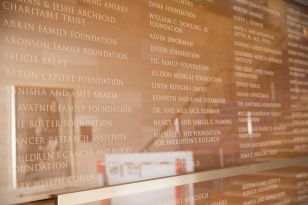Relaxation techniques ease patients' fear, anxiety about radiation treatments
Patients who are anxious and fearful as they embark on a course of radiotherapy to treat their cancer may find relief from those symptoms through relaxation techniques.
A recent pilot project has found that a multimodal, multisensory wellness intervention can indeed make a difference.
The impetus behind this integrative health and wellness program at NewYork-Presbyterian/Weill Cornell Lower Manhattan Cancer Center (LMCC) was to provide “compassionate, connected care” to patients undergoing radiation and thus help them to manage the side effects and stress often associated with radiation treatments.
The inspiration came from Leonard A. Farber, M.D., clinical director of radiation oncology at LMCC. To carry this mission forward, Manna Lu-Wong, RN, a dual-licensed nurse and acupuncturist, who is also certified in other complementary modalities including Reiki, Urban Zen Integrative Therapy, and Yoga4Cancer, was hired to provide integrative health and wellness services at LMCC in January, 2015. Shortly thereafter, Wong wanted to find out if the idea was working, and suggested, “Let’s do a pilot study to see if [these services] are having a significant impact on patients.”
The small study was carried out over 4 months and involved quantitative pre- and post-intervention assessments of 24 patients aged 40-79 years who were undergoing radiation therapy at the cancer center. The four-part relaxation intervention consisted of a 30-minute combined Reiki (healing touch), sound therapy, music therapy, and aromatherapy. Each patient’s vital signs (blood pressure, heart rate, and respiration) were measured before and immediately following the intervention, as were their pain and anxiety levels using standard statistical assessments.
Significant, immediate effects were observed in reduced heart rates and anxiety, said Wong, not only providing evidence of the benefits of the intervention for radiation oncology patients, but also establishing a rationale for further studies using a larger sample size and carried out over a longer period of time.
A Multimodal Integrative Health Approach
The serene Reiki room atmosphere at LMCC is designed to address multiple senses through its dim lighting, music, aromatherapy, and Reiki. Wong credits this combined approach for its success. “I created a unique protocol that incorporates acupressure/self-massage, Reiki, music, sound healing (Tibetan singing bowls), breath awareness meditation, and yoga in one session.” Wong said that she also assesses specific patient symptoms, and provides tailored treatments; for example, if patients have dry mouth, anxiety, or pain, she will instruct them in self-massage on areas that address these symptoms. For aromatherapy, lavender is helpful to address anxiety, and citrus/peppermint help with symptoms of fatigue or nausea. Breath awareness is also part of the protocol, and Wong typically ends the session with sound therapy playing the Tibetan singing bowls for about 5 to 10 minutes, all with the goal of relaxing the patient and reducing stress.
The relaxation modalities are fully integrated into LMCC’s radiation oncology unit. At the first radiation oncology consult, the free services are explained and offered to each patient. In addition, patients who show specific signs of anxiety prior to a radiation therapy session—for example, as a result of claustrophobia—can be referred by their nurses or other clinicians to the center for a brief Reiki or similar relaxation treatments.
For this population, Wong added, “fear and anxiety are among the more prevalent symptoms,” along with the cumulative effect of dealing with the cancer itself, and, for many, balancing the need to continue to work during treatment.
Patient feedback thus far has been extremely positive. “The patients love it, and they want to learn more about it,” said Wong. By offering the services and educating patients about their benefits, she added, “We are really promoting wellness.”
When patients are discharged from their radiation regimens, they often look for other practitioners so that they can continue the therapy, or, they find that they have learned enough about the process to integrate it into their daily lives.
While the program began specifically for the radiation oncology patient, Wong is now working with the Patient Family Advisory Council in promoting health and wellness at sponsored events. Alka Gupta, M.D., and Chiti Parikh, M.D., co-directors of Integrative Health at NYP Cornell, are implementing these health and wellness services in the health system.
“A lot has happened since our pilot study. It has set the stage for something bigger.”




